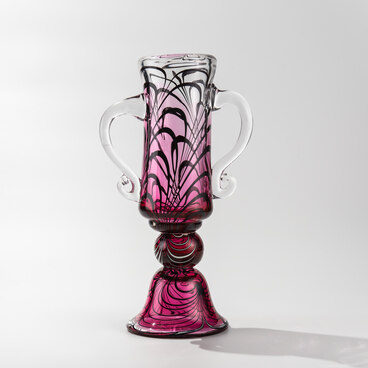Pressing is a technique of forming glass products by pressing the glass mass into a cast iron mold. Hand pressing was known as early as the 16th century when glass pendants for chandeliers and mosaics were made. In the 18th century, hand pressing was used in Europe to make stoppers for decanters, goblet stands, salt cellars, and other small items.
Machine pressing was introduced on an industrial scale in Russia in the early 20th century. The first foreign pressing machines were installed at the Dyatkovo Crystal Factory even earlier, in the second half of the 19th century. It was possible due to the new regenerative glass furnaces, which operated using wood gas instead of firewood.
The automatic machine pressing gained widespread use in the 1970s. After large-scale modernization, the Dyatkovo Crystal Factory put into operation a specialized workshop for producing crystal items using the Soviet APP-12 automatic machines. The significance of this event was that neither Soviet nor foreign factories had ever processed crystal products on automatic machines using the new fire polishing technique. Fire polishing is a method of polishing a material by exposing it to the flame of a gas burner for a very short time, during which surface tension improves the surface by smoothening it and giving it a gloss. The precision of pressing procedures ensures close replication of original patterns in mass-produced items.
An ashtray is one of the most important smoking accessories. Most often, ashtrays are made of fire-retardant materials, such as metal, pottery, glass, heat-resistant plastic, and crystal. There are various types of ashtrays designed specifically for smoking pipes, cigars, and cigarettes. Cigar ashtrays have deeper and wider edge indentations.
The crystal ashtray from the exhibition was made using the pressing technique in 1954.
Machine pressing was introduced on an industrial scale in Russia in the early 20th century. The first foreign pressing machines were installed at the Dyatkovo Crystal Factory even earlier, in the second half of the 19th century. It was possible due to the new regenerative glass furnaces, which operated using wood gas instead of firewood.
The automatic machine pressing gained widespread use in the 1970s. After large-scale modernization, the Dyatkovo Crystal Factory put into operation a specialized workshop for producing crystal items using the Soviet APP-12 automatic machines. The significance of this event was that neither Soviet nor foreign factories had ever processed crystal products on automatic machines using the new fire polishing technique. Fire polishing is a method of polishing a material by exposing it to the flame of a gas burner for a very short time, during which surface tension improves the surface by smoothening it and giving it a gloss. The precision of pressing procedures ensures close replication of original patterns in mass-produced items.
An ashtray is one of the most important smoking accessories. Most often, ashtrays are made of fire-retardant materials, such as metal, pottery, glass, heat-resistant plastic, and crystal. There are various types of ashtrays designed specifically for smoking pipes, cigars, and cigarettes. Cigar ashtrays have deeper and wider edge indentations.
The crystal ashtray from the exhibition was made using the pressing technique in 1954.



